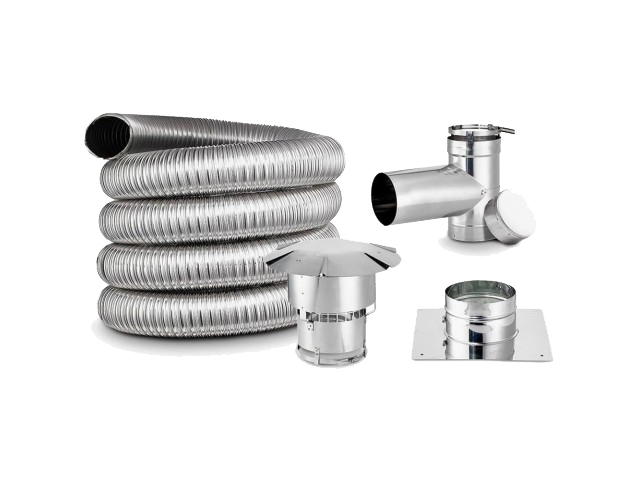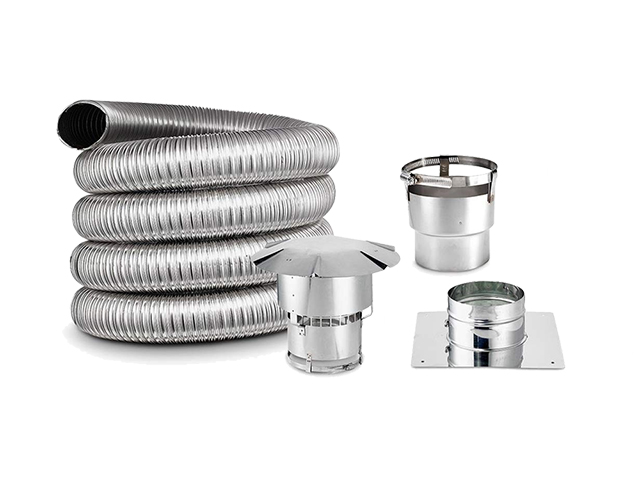Posted by Jeffrey Swerdan on Oct 18th 2023
Which Chimney Liner is Best For Me?
This Article has been approved by our on staff NFI Certified Specialists & Master Hearth Professionals
Which Chimney Liner is Best For Me?
Choosing the proper Chimney Liner is important for a number of reasons. Chimney Liners can improve the safety of your chimney system. Chimney liners also help improve the draft in your chimney system which in turn, helps to improve the efficiency of your fireplace, wood stove, and other heating appliances. A chimney liner also helps protect your chimney walls from heat and corrosion as well.
For Chimney Liners, you will want to look at the material, type, and size options to determine which option is best for you
There are a number of things to look for when starting a chimney liner project. First, you will need to determine what type of heating appliance you want to vent. You will also need to know what type of fuel the appliance uses. Does the appliance burn wood, coal, oil, or gas? Most Chimney Liners are rated to exhaust all wood fuel types, but there are some liners that can not exhaust all fuel types. Knowing which fuel your system uses will help you determine if the chimney liner is rated for use with your system.
Chimney liners come in a variety of sizes including 4-inch, 6-inch, 8 inches and larger
The next thing you will want to determine is the size of the liner that is needed for your project. You will need to know two things; what diameter of chimney liner you need as well as how long the liner has to be to make it from the top of your heating appliance all the way up your chimney flue to the roof. If you refer to your appliance manual, it will list the recommended size of liner to use with your appliance. You can also measure the venting outlet that is attached to your appliance as well.
Next, you will need to know if you need to have a rigid liner or a flexible liner. Rigid liners have a smooth wall which is better for venting oil and gas-burning appliances. Flexible liners offer more versatility when installed as they can bend and maneuver around offsets in the chimney flue, while the rigid chimney liner can only be installed in a straight chimney with no curves or bends. Flexible liners also come in kits that include the appliance connector as well as the roof termination and a rain cap.
Flexible Metal Chimney liners are the most popular style and come in aluminum, stainless steel, and kits
The next thing to consider is the grade of chimney liner that you need. The grade refers to the thickness of the material used to manufacture the chimney liner. There are aluminum chimney liners as well as stainless steel liners. The Aluminum liners can only be used with select natural gas and propane appliances. They are usually very lightweight and relatively easy to install. These resemble and feel like your dryer duct venting.
There are mainly two grade types for stainless steel chimney liners and those are 316 and 304. The 304-grade stainless steel liners are a common choice for wood-burning applications. The 304-grade liners offer good corrosion resistance but may not be suitable for some high-heat or highly acidic environments. The 316 Stainless steel offers a higher corrosion resistance than the 304 grade. This makes it more suitable to be used for wood, gas, and oil-burning appliances. You will also find 316Ti Stainless steel. This is the premium-grade chimney liners and this material has an even higher resistance to corrosion and high temperatures. This type is often used for wood-burning stoves and appliances.
The stainless steel chimney liners are the most popular type of liners, but there are also cast-in-place liners that involve pouring a special cement-like material into the chimney flue. There are also the traditional clay tile liners that are still used in some masonry chimneys. These are very durable and provide good insulation but they can crack over time and are more expensive to repair.
Whether you are replacing an existing liner or looking at relining your clay or masonry chimney for the first time, a flexible chimney liner can be a great option./h3>
A flexible chimney liner has a number of benefits including improved safety, increased efficiency, easier installation, better insulation, more cost-effective, reduced heat transfer, and is easier to maintain than traditional rigid chimney pipe. You and your installer will love the ease of use of chimney liners and the increased efficiency will help you be less dependent on energy companies.
Northline Express offers DuraVent brand chimney liners as well as Lifetime Chimney Liners
DuraVent is a trusted brand of venting components. Duravent was one of the first manufacturers to come to market with new innovations in venting solutions. They have become one of the leaders in professional and quality venting products. Duravent Chimney Liners come in a few different options. They offer DuraFlex AL which is their aluminum brand of chimney liners as well as Dura Flex SS which is their stainless Steel option. Dura Liner is their rigid chimney liner brand.
The Northline Express brand of choice when it comes to Chimney Liners is the Lifetime Chimney Liners. Their chimney liners are UL-listed with 316L grade stainless steel. This material is strong enough to withstand the extreme heat produced by a fire and can withstand the intense constant conditions within your masonry chimney. Lifetime brand Chimney Liners also offers one of the best warranties in the industry. The warranty is straightforward and comes without a bunch of loopholes and fine print. Lifetime brand Liners feature a smooth wall system and they offer all of the components you need in convenient all-in-one liner kits. They produce dependable and reliable products at an affordable low price.
A Chimney Liner kit comes with all of the components you will need for an install
A Chimney Liner kit comes with 4 components. It comes with a tee to connect your appliance and to give you clean-out access, a top plate to attach to your roof, a cap to prevent rain and water from falling in the venting, and the flexible chimney liner itself. For most installations, this is all you will need. The components are also all sold separately if your project is a little different and your installer needs a different kind of setup.
Northline Express has options for insulated chimney liners as well as non-insulated liners
There are a few factors on whether or not you want to choose an insulated liner or a non-insulated liner. The first is the type of heating appliance that you have and the type of fuel that you burn. It will also depend on the area that you live in and the conditions of your existing chimney flue.
An insulated chimney liner is normally used for wood-burning stoves and fireplaces and helps to improve draft and can also help minimize the creation of creosote and condensation in your venting system. Non-insulated liners are generally sufficient to use for gas and oil-burning appliances because these types of appliances will produce higher flue gas temperatures when compared to a wood-burning unit.
FAQ - Buying Chimney Liners
Are chimney liners worth it?
The short answer is Yes. A properly installed chimney liner has several benefits. Some of the advantages include improved safety and increased efficiency of your appliance, easier installation, longevity, easier maintenance, and better insulation. The other big factor is that chimney liners are one of the most cost-effective chimney venting options. They save you money on installation and system maintenance, and because of their increased efficiency, they can even save you money on your home heating bills in the long term.
Can you put a liner in an old chimney?
In most cases, a chimney liner is the best way to line an old chimney flue. You will need to have the chimney inspected by a qualified chimney sweep or professional. They will need to assess the overall condition of the chimney to make sure that the flue still complies with all of the current safety and building codes. They will also make sure that there is no hidden damage that may impede the ability to install a liner system. Also, they will be able to help you gather measurements to make sure you get the proper size liner system. An inspection of your current system will let you know whether or not you need an insulated chimney liner or not.
Can you install a chimney liner by yourself?
Installing a chimney liner is not a one-person job. It will require at least two people, if not more. The flexible chimney liners come as one long piece of tubing that can be anywhere from 25 feet long to 50 feet long, or longer on some commercial applications. The longer the liner gets the heavier it is and trying to get it up on the roof and down through the flue can be a tall order for a single person. It may be worth getting some quotes from qualified professionals in your area, so you can weigh the option of doing it yourself versus having a company handle the installation. You just want to make sure that whoever you have do the installation is licensed, bonded, and insured.
What size chimney liner do I need?
The size chimney liner that you need is dependent upon two things. First, is the diameter of the liner that you need. This is determined by the outlet size of your heating appliance and the diameter size that is recommended in the manual for the heating appliance. The Second thing is the length that is required to get you from the outlet of the heating appliance up to the roof line of the building.
How much is the average cost of what a stainless steel liner should be?
The average price range of stainless steel flexible chimney liners is between $20 and $40 per linear foot. The price will vary depending on the grade of stainless that you choose and the overall length and diameter of the liner that your project calls for.
How much does it cost to install a chimney liner?
The cost of installation varies greatly depending on the area that you are in and the season in which you want it installed. It will also depend on the complexity of the job. On the low end, you could expect to pay anywhere between $1,000 to $3,000 for a simple install, whereas a more complex install could be $5,000 or more.
Where can I go to learn more about Chimney Liners?
Northline Express offers a Resource Center with helpful articles on a variety of topics. Here are some of the Chimney Liner articles that we offer:
- Can Installing a Chimney Liner myself save me hundreds
- What Measurements and Tools you need to install your Chimney Liner
- How to Install a Chimney Liner
- Which Chimney Liner is Best for Me
- Duraflex Flexible Chimney Relining System
- DuraLiner Chimney Relining System

Single Wall Chimney Liner Kits
Single Wall Chimney Liner is strong, easy to install and affordable chimney liner to vent your heating appliance through a masonry chimney.
Shop Now
Smooth Wall Chimney Liner Kits
The smooth inner wall of the Smooth-Wall liner delivers up to 20% greater draft over equal size corrugated pipe for increased efficiency and improved performance of your heating appliance.
Shop Now
